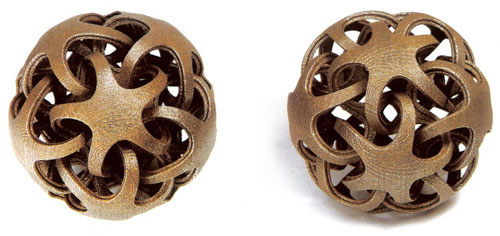
This Article From Issue
January-February 2009
Volume 97, Number 1
Page 73
DOI: 10.1511/2009.76.73
THE SYMMETRIES OF THINGS. John H. Conway, Heidi Burgiel and Chaim Goodman-Strauss. xviii + 426 pp. A K Peters, 2008. $69.
Of the many joyful obsessions that can inhabit the human mind, a preoccupation with geometric symmetries might be the one that unites the bearer with the most fascinating and intense community of compatriots. Some of the afflicted are artists entranced by the most primal foundations of order. Some are philosophers interested in the remarkably concise Platonic playground given to us. Many are scientists or mathematicians, of course, but there are also dancers, devotees of spiritual disciplines and textile designers, plus many others who have no plausible excuse.

From The Symmetries of Things.
This community is given an unusual, delightful treat with the publication of The Symmetries of Things, by John H. Conway, Heidi Burgiel and Chaim Goodman-Strauss. Some of my math friends awaited delivery of this book with the tortured anticipation of a child waiting for a new toy to arrive in the mail. When I got a copy for review, a number of rather jealous e-mails protested that it wasn’t fair I should get to see it first.
There was reason to be jealous, as it turns out. This book is a plaything, an inexhaustible exercise in brain expansion for the reader, a work of art and a bold statement of what the culture of math can be like, all rolled into one. Like any masterpiece, The Symmetries of Things functions on a number of levels simultaneously.
Already the book is having reverberations in the mathematical community, where it is widening the vocabulary of symmetries in play. For instance, Berkeley computer scientist Carlo Séquin, when confronted with the amazing Triamond, which combines qualities of a diamond lattice with a helix, began creating sculptural realizations of it—something that had never been done before. As a result, we now know that this rather abstract, obscure symmetry can be rendered in tangible three-dimensional forms. (Séquin’s Triamond can be viewed on slides 53 and 54 at http://www.cs.berkeley.edu/~sequin/TALKS/Bridges08_Talk.ppt.)

From The Symmetries of Things.
What is perhaps most remarkable about The Symmetries of Things is that it is written for a broad audience. The text starts off super-easy, with celebrations of familiar patterns that might be seen in masonry or on Hawaiian shirts. The visual style is simply luscious—the gorgeous color illustrations use computer graphics in a playful way that avoids any clinical feeling.
The rigorous side of the presentation rises so gently that you might not even realize you’re reading a genuine math book until a few chapters in. Toward the end of the book, the math gets heavier, of course, and less technically inclined readers will be left behind. But along the way, an implicit proof by construction is presented about the viability of a new kind of mathematical communication: It is, we see, possible to blend rigorous explication with pop accessibility.
That doesn’t mean it’s easy to do. This book is a virtuoso performance that will be hard to emulate, but its existence will, I hope, spur more attempts along the same lines.
For instance, the proof that there are only 17 symmetry types on the plane is presented unconventionally. At first you are given a cost-accounting metaphor that anyone can understand, which only turns into a proof much later. Someone who isn’t analytically minded can get the feeling of the proof even if they don’t follow the argument all the way to its conclusion.
The Symmetries of Things is visually fetching enough, and accessible enough, that it could be successful as a coffee-table book. But it won’t be, because it’s too expensive. Here we come to an annoying aspect of scientific communication at the present moment. The book lists for $69, and even online the going price is about $55. That is tragic, because a whole audience that might be introduced to math in a new way will not be, because they won’t be able to afford the chance. Of course one hopes that a paperback version will appear soon.
Unfortunately, at this time the only alternative to publishing one’s work as an insanely expensive book is to offer it online at an insanely low price (for free). I realize I hold a minority opinion, but here it is for your appraisal: An epic accomplishment like The Symmetries of Things isn’t going to appear online first as long as the ideology that content should be free holds sway. It takes a huge amount of labor to make something like this book, more than can be offered on a volunteer basis. Furthermore, if passages of this book were sampled and mashed-up as free things are online, the emergent beauty of the presentation would be lost. Tragically, at this moment in history, it is paper, and not the Internet, that is supporting the most daring and radical developments in mathematical communication.
The ideal outcome would be a compromise, in which works like The Symmetries of Things are made available at prices affordable to everyone—and in this case, I’m convinced that many people would want to read it—but in a way that funds the creators and maintains the integrity of the whole expression.
It’s a challenge to find fault with this book. I can only come up with one small disappointment: Every symmetry-obsessed person has his or her favorite symmetries, and as it happens, the book does not give some of my favorites their due. I’m obsessed with the symmetries arising from the real projective plane, such as the hemicube, or the amazing hendecachoron (also known as the 11 cell), but somehow the authors have failed to feature them.
As a computer scientist, I’d like to note that without an awareness of the principles of symmetry, there would be no way to store and retrieve information. There has to be a pattern of some kind so that one knows where to look for a bit. Every bit we make is an example of symmetry breaking. What makes the study of symmetry truly luminous, however, is the realization that the vocabulary of symmetries is rather limited. There are only 17 types of patterns on the plane, as noted earlier, and only five Platonic solids in three dimensions. The book gives a grand tour of other examples: 35 prime space groups, 184 composite space groups, and so on. This limited vocabulary of symmetries is universal. It is as true for all possible aliens as it is for us humans. The paucity of symmetries unites us with all possible life in a cosmic language.
One of the current dramas in physics is Garrett Lisi’s controversial proposal that a grand unified theory can be based on the exceptional Lie group E8. The root lattice of E8 is a stellated four-dimensional Platonic polyhedron-like object called the 120 cell, which looks like a more elaborate version of the familiar dodecahedron, one of the five Platonic solids in three dimensions. There are rather few symmetrical objects with which theories can be formulated, and that rarity makes it likely that even if Lisi turns out to be wrong, there’s an alien physicist somewhere in a distant galaxy who has had a similar thought.
It’s hard for me to imagine a reader going through even the first few chapters of The Symmetries of Things without feeling a sense of awe and connectedness with cosmic commonality. It is imperative to get this book into the hands of as many young mathematicians as possible. And then to get it into everyone else’s hands.
Jaron Lanier, who is a computer scientist, composer, visual artist and author, is Interdisciplinary Scholar-in-Residence, Center for Entrepreneurship and Technology, University of California, Berkeley.

American Scientist Comments and Discussion
To discuss our articles or comment on them, please share them and tag American Scientist on social media platforms. Here are links to our profiles on Twitter, Facebook, and LinkedIn.
If we re-share your post, we will moderate comments/discussion following our comments policy.